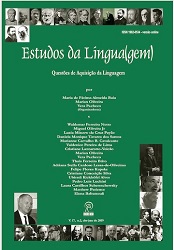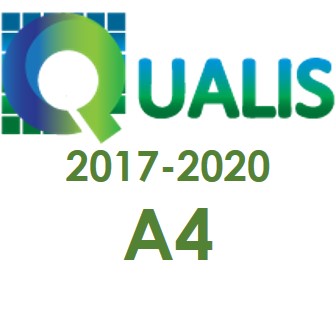Melodies of child: Greek-English phonological interference (Melodias de criança: interferência fonológica grego-inglês)
DOI:
https://doi.org/10.22481/el.v17i2.5347Palavras-chave:
Bilingualism; Language acquisition; Prosody, Bilinguismo; Aquisição da Linguagem; Prosódia.Resumo
In this paper, I will operationalise phonological interference in terms of psycholinguistic and phonological theory by utilizing a Greek-English bilingual girl’s naturalistic speech data for a month at age 2;7, in a language pair that is not researched much in bilingualism. The ultimate goal is to decipher the psycholinguistic and linguistic processes involved in the child’s phonological interference at a qualitative level (the melodic tier), also backed by in-depth quantitative evidence. Phonological interaction is scrutinised in the child’s developing phonologies in an under-represented linguistic context: one of the languages (English) is exogenously acquired and, thus, characterized by compromised exposure in terms of quantity and quality of input. The results sustain the manifestation of phonological interference at both the surface and underlying levels of only certain melodic units in the bilingual’s languages, rather than across the board. The ensuing analyses illuminate the indisputable interaction of several developments at work.
Neste artigo, operacionalizarei a interferência fonológica em termos de teoria psicolinguística e fonológica, utilizando dados naturalísticos de uma menina bilíngue greco-inglesa de 2;7 anos, em um par de idiomas que não é muito pesquisado no bilinguismo. O objetivo final é decifrar os processos psicolinguísticos e linguísticos envolvidos na interferência fonológica da criança em um nível qualitativo (o nível melódico), também apoiado por evidências quantitativas. A interação fonológica é examinada nas fonologias em desenvolvimento da criança em um contexto linguístico sub-representado: uma das línguas (inglês) é adquirida exogenamente e, portanto, caracterizada pela exposição comprometida em termos de quantidade e qualidade de entrada. Os resultados sustentam a manifestação da interferência fonológica tanto na superfície quanto nos níveis subjacentes de certas unidades melódicas nos idiomas bilíngues, mas não em todo o quadro melódico. As análises que se seguem iluminam a interação indiscutível de vários desenvolvimentos.
Downloads
Referências
BABATSOULI, E. (forthcoming2). Prolegomena. In BABATSOULI, E. (Ed.), On under-reported monolingual child phonology. Bristol, UK: Multilingual Matters.
BABATSOULI, E. A phonological assessment test for child Greek. Clinical Linguistics and Phonetics. 2019.
BABATSOULI, E. Bilingual development of theta in a child. Poznan Studies in Contemporary Linguistics, v. 53, n.2, p. 157-195. 2017.
BABATSOULI, E. Technologies for the study of speech: Review and an application. Themes in Science and Technology Education, v. 8, n. 1, p. 17-32, 2015.
BABATSOULI, E; BALL, M. J. (forthcoming). Introduction. In BABATSOULI, E; BALL, M. J. (Eds.), An anthology of bilingual child phonology. Bristol, UK: Multilingual Matters.
BABATSOULI, E; INGRAM, D. Prologue. In BABATSOULI, E; INGRAM, D (Eds.), Phonology in protolanguage and interlanguage (pp. 1-23). Sheffield, UK: Equinox Publishing, 2018.
BABATSOULI, E; KAPPA, I. Transfer of Greek palatals in L2 English. In WREMBEL, M; KUL, M.; DZIUBALSKA-KOŁACZYK, K (Eds.), Achievements and perspectives in the acquisition of second language speech: New Sounds Frankfurt: Peter Lang, 2010. p. 27-42.
BABATSOULI, E; NICOLADIS, E. The acquisition of English possessives by a bilingual child: Do input and usage frequency matter? Journal of Child Language, v. 46, n.1, p. 170-183, 2019.
BERNARDINI, P; SCHLYTER, S. Growing syntactic structure and code-mixing in the weaker language: the Ivy Hypothesis. Bilingualism: Language and Cognition, v. 7, n.1, p. 49–69, 2004.
BRANNEN, K. The role of perception in differential substitution. Canadian Journal of Linguistics - Revue Canadienne de Linguistique, v. 47, p. 1-20, 2002.
BRIÈRE, E. J. A Psycholinguisitc study of phonological interference. The Hague/Paris: Muton. 1968.
BUNTA, F; DAVIDOVICH, I; INGRAM, D. The relationship between the phonological complexity of a bilingual child’s words and those of the target languages. International Journal of Bilingualism, v. 10,. 1, p. 71-88. 2006.
ECKMAN, F. R; ELREYES, A; IVERSON, G. K. Some principles of second language phonology. Second Language Research, v. 19, n. 3, p. 169-208, 2003.
EDWARDS, J. G. H.; ZAMPINI, M. L. (Eds.) (Phonology and second language, Philadelphia: John Benjamins, 2008.
FLEGE, J. E; DAVIDIAN, R. Transfer and developmental processes in adult foreign language speech production. Applied Linguistics, v. 5, n. 3, p. 23-347, 1984.
GASS, S. M; SELINKER, L. (Eds.) Language transfer in language learning. Cambridge, MA: Newbury House, 1982.
GROSJEAN, F. Studying bilinguals, Oxford: Oxford University Press, 2008.
GROSJEAN, F. (2012). An attempt to isolate and then differentiate transfer and interference.International Journal of Bilingualism, v.16, n. 1, p. 11-21, 2012.
GRUNWELL, P. The development of phonology. First Language, n. 3, p. 161-191, 1981.
HAMBLY, H; ET AL. The influence of bilingualism on speech production: A systematic review. International Journal of Language and Communication Disorders, v. 48, p. 1-24, 2013.
INGRAM, D. e al. The acquisition of word-initial fricatives and affricates in English by children between 2 and 6 years. In YENI-KOMSHIAN, G. H; KAVANAUGH J. F; FERGUSON, C. A. Child phonology, Vol. I: Production. New York: Academic Press, 1980. p. 169-192
JAKOBSON, R. Child language, phonological universals and aphasia. The Hague: Mouton. 1941/1968.
KEHOE, M. Crosslinguistic interaction in early bilingual phonology: A critical review. In Babatsouli, E; Ingram, D. (Eds.), Phonology in protolanguage and interlanguage . Sheffield, UK: Equinox Publishing, 2018. p. 49-75.
LEOPOLD, W. F. Speech development of a bilingual child: A linguist’s record. Evanston, IL: Northwestern University Press, 1949.
LLEÓ, C; CORTÉS, S. Modeling the outcome of language contact in the speech of German-Spanish and Catalan-Spanish bilingual children, International Journal of the Sociology of Language, 221, 101-125, 2013.
MAJOR, R. C. Phonological differentiation of a bilingual child. Papers in Psycholinguistics and Sociolinguistics. Working Papers in Linguistics, v. 22, p. 88-122, 1977.
MAJOR, R. C. Transfer in second language phonology. In J. G. H. Edwards & M. L. Zampini (Eds.), Phonology and second language acquisition Philadelphia/Amsterdam: John Benjamins, 2008. p. 63-94.
MACWHINNEY, B. The CHILDES project: Tools for analyzing talk. Mahwah, NJ: Lawrence Erlbaum, 2000.
MAGOULA, E. The acquisition of the phonological system in Modern Greek: The case of consonants. Unpublished doctoral dissertation. University of Athens, Greece, 2000.
MCLEOD, S. The international guide to speech acquisition. Clifton Park, NY, Thomson Delmar Learning, 2007.
MCLEOD, S; BLEILE, K. Neurological and developmental foundations of speech acquisition. Invited seminar presentation at the American Speech and Hearing Association Convention, November 2003, Chicago, IL.
MEISEL, J.‘Early differentiation of languages in bilingual children’, in K. Hyltenstam & L. Obler (eds.), Bilingualism across the lifespan: Aspects of acquisition, maturity and loss. Cambridge: Cambridge University Press, 1989. p.13-40.
MOSKOWITZ, A. I. Acquisition of phonology. Unpublished doctoral issertation, University of California, Berkeley, USA, 1971.
MOULTON, W. (1962). Toward a classification of pronunciation errors. Modern Language Journal, n. 46, p. 101-109, 1962.
Nespor, M. Phonology. Athens: Patakis Publication (adapted for Greek by A. Ralli & M. Nespor), 1999.
OHALA, J; RIORDAN, C. Passive vocal track enlargement during voiced stops. Report of the Phonological Laboratory UC Berkeley, n. 5, p. 78-87, 1980.
ODLIN, T. Cross-linguistic influence. In DOUGHTY, C; LONG, M. H. (Eds.), The handbook of second language acquisition. Cambridge, MA: Blackwell, 2008. p. 436-486.
PARADIS, J. Beyond ‘One system or two’: Degrees of separation between languages of French - English bilingual children. In DÖPKE, S (Ed.), Cross-linguistic structures in simultaneous bilingualism. Amsterdam/Philadelphia: John Benjamins, 2000. p. 175-2000.
PARADIS, J; GENESEE, F.‘Syntactic acquisition in bilingual children: Autonomous or inderdependent?’ Studies in Second Language Acquisition, v. 18, n. 1-25, 1996.
PIENEMANN, M; KEßLER, J. Measuring bilingualism. In: AUER, P; WEI, L. (Eds.) Handbook of multilingualism and multilingual communication The Hague: Mouton de Gruyter, 2007. p. 247-267.
PRINCE, A; SMOLENSKY, P. Optimality theory: Constraint interaction in generative grammar. Oxford: Basil Blackwell, 2004.
SMIT, A. B. Phonologic error distributions in the Iowa-Nebraska articulation norms project: Consonant singletons. Journal of Speech and Hearing Research, v. 36, p. 533-547, 1993.
SMITH, J. Phonological augmentation in prominent positions. Unpublished doctoral dissertation. University of Massachusetts, Amherst, USA, 2002.
SMITH, N. V. The acquisition of phonology: A case study. Cambridge Studies in Linguistics 25, Cambridge: Cambridge University Press, 1973.
TEMPLIN, M. Certain language skills in children: Their development and interrelationships. 1957. Monograph. The University of Minnesota Press, 1957.
VOLTERRA, V; TAESCHNER, T. The acquisition and development of language by bilingual children. Journal of Child Language, Cambridge, v. 5, p. 311-326, 1978.
WEINREICH, U. Languages in contact: findings and problems. Mouton: The Hague, 1953.
WEINREICH, U. Explorations in semantic theory. Mouton: The Hague, 1966.
Downloads
Publicado
Como Citar
Edição
Seção
Licença
Autores que publicam em Estudos da Língua(gem) concordam com os seguintes termos:
Estudos da Língua(gem) mantém os direitos autorais das contribuições publicadas e disponibiliza seu conteúdo gratuitamente por meio do portal. Autores têm permissão e são estimulados a publicar e distribuir seu trabalho online em repositórios institucionais ou na sua página pessoal, com reconhecimento de autoria e créditos de publicação inicial nesta revista, indicando endereço online.






